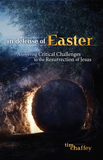Seed of Promise in Genesis 3:15
The gospel is not something God hid until Jesus came in the flesh. After Adam’s Fall, God shared the seeds of a plan He had already worked out before time began.
Private conversations between individuals have often turned the tide of history. Think of just one example: the secret meetings between Roosevelt and Churchill, settling the Allies’ war aims before the United States’ entry into World War II. We’d all be surprised if we knew how much our everyday lives are affected by conversations among powerful individuals at the highest levels of government and society. Yet the combination of all those conversations pales in comparison to a brief, tragic conversation that took place in a beautiful garden six thousand years ago.
The conversation is recorded for us in Genesis 3. It was a dark episode in human history—involving a serpent, a woman, a man, and God. Yet from this scene shines forth the greatest beacon of hope the lost world has ever known.
That beacon is found in fifteen simple
but profound Hebrew words of verse
15. Theologians have called them the protoevangelium, that is, the first
(proto-) announcement of the good
news of the gospel (evangelium). God
addressed these sober words to the
satanic power behind the serpent: “And
I will put enmity between you and the
woman, and between your seed and her
Seed; He shall bruise your head, and
you shall bruise His heel.
”
For centuries, Christians have argued that this verse proves God established His plan of redemption through Jesus Christ from the very beginning (Ephesians 1:4). Because these words were written thousands of years before His death on the Cross, they prove the Lord oversaw every word of Scripture—and every incident of history—to unfold His sovereign, eternal plan. In recent days, however, this interpretation has come under attack by skeptics, Jews, and even some evangelicals. Let’s take a closer look at the account to see if this verse really is prophetic.
The Backdrop
Before this scene, Genesis says the Lord placed the first man and woman in an ideal environment with only one restriction—don’t eat from one tree (Genesis 2:16–17). He actually gave that command to the man before the woman was created. It was the man’s responsibility to communicate God’s words correctly to his wife. But chapter 3 interjects a series of jarring notes into the beautiful music of this young creation:
- Conversation with the Woman (3:1–5)
- Committing the Sin (3:6)
- Consciousness of the Sin (3:7–8)
- Confronting the Sinners (3:9–13)
- Consequences of the Sin (3:14–24)
Most readers are familiar with this background. But it is important to remember the context of the judgment against the serpent. It is the first of a series of judgments pronounced on three guilty parties. In this dark context a beacon of hope finally emerges. Before the pronouncements on the woman and the man, the Lord promises irredeemable judgment on the serpent:
So the Lord God said to the serpent: “Because you have done this, you are cursed more than all cattle, and more than every beast of the field; on your belly you shall go, and you shall eat dust all the days of your life. And I will put enmity between you and the woman, and between your seed and her Seed; He shall bruise your head, and you shall bruise His heel.” (3:14–15)
Embedded within these ominous words of doom is mankind’s only hope—the seed of the woman, the Deliverer, the Savior, the Messiah. The promise declares that the coming one will not arrive, however, before a fierce conflict develops. Here is a promise not only of hope but also of warfare. The Hebrew language and its wider context are referring to something greater than mankind’s loathing of snakes. The verse could refer only to a battle between followers of the Lord and of Satan.1
Messiah’s Complete Defeat of Satan
Ultimately, the conflict will focus
on two individuals. The word seed in
Hebrew (zerah) has both a collective
and an individual meaning—just like
its English equivalent. The singular
pronoun used in the promise, “He [KJV,
‘it’] shall bruise your head,
” indicates
that a male member of the human race
will deliver a fatal and final blow to the
serpent. This crushing blow will not
come, however, without the woman’s
seed also receiving a wound, although
not a final one, on His heel.
Embedded within these ominous words of doom is mankind’s only hope—the seed of a woman.
Until modern times, Jewish commentators saw a prophecy of the coming Messiah in this verse. Consider, for example, this comment from Bereshit Rabba 23, a rabbinic commentary on Genesis: “Eve had respect to that seed which is coming from another place. And who is this? This is Messiah the King.” As we look back on this promise in the light of later revelation in the Hebrew Bible and its fulfillment in the New Testament, its general and rather mysterious truths shine brightly to the eye of believers. Basically, this verse teaches that Messiah will suffer in the process of finally defeating Satan. The concept of a suffering Messiah, although unfamiliar to many Jewish people, can be traced back to this ancient promise. Isaiah further developed this theme with his teaching about the suffering servant. Consider Isaiah 53:5: “He was bruised for our iniquities,” and Isaiah 53:10: “Yet it pleased the Lord to bruise Him” (italics added).
The New Testament is clear
that Messiah accomplished
this victory at the Cross (consider
Hebrews 2:14–15). The
New Testament is also clear
that the final punishment and
total disabling of Satan await
the end times. Romans 16:20
promises that the church (in Christ) will
be victorious: “And the God of peace will
crush Satan under your feet shortly.
” The
book of Revelation portrays this final
fulfillment at the Great White Throne
Judgment (Revelation 20:11–15). It is
clear that while Satan is truly alive, he is
not well on planet earth! He is a defeated
foe, although his final doom awaits him.
Messiah’s Unique Nature
What basic truths can we discover about Messiah from Genesis 3:15, as we look back through the light of later revelation? God often gave enigmatic prophecies, which He made more explicit in later revelation (see 1 Peter 1:10–12).
First, Messiah will be of unique birth—He will be the seed of the woman. Although we should be patient with someone who has difficulty seeing the truth of the virgin birth in these veiled words of God, it is implied that the deliverer will be of unique origin. Else, why is He called the seed of the woman and not the seed of the man?
Second, Messiah will be supernatural—He will defeat Satan, a supernatural being. Only one who has power beyond that of mere man can defeat him who is called “the prince of the power of the air” (Ephesians 2:2). Thus, Messiah’s deity is hinted at.
Third, Messiah will be of the human race—He will be from a woman, not an angel or a visitor from another world. Thus, if the seed is truly supernatural and human, the ultimate mystery begins to unfold—Messiah will be both God and man—a theme later developed by the prophets (Isaiah 9:6; Jeremiah 23:5–6; Micah 5:2). We must remember that this promise is only the beginning of a long series of Messianic prophecies. As revelation unfolds, more information will come forth and Messiah’s credentials will progressively narrow the focus to one of who will be a descendant of Shem, Abraham, Isaac, Jacob, Judah (Genesis 9:26, 12:3, 26:3, 35:11–12, 49:10), David (2 Samuel 7:12–16), and Zerubbabel (Haggai 2:23), and He will be born in Bethlehem (Micah 5:2) before the Temple is destroyed (AD 70; Daniel 9:24–26). Like an inverted pyramid, this portrait of Messiah rests on the only one who could fit these and the many other prophecies concerning Him—Jesus of Nazareth, born of a woman (Galatians 4:4), who vanquished Satan and sets free those who are in satanic bondage (Hebrews 2:14–15).
Answers Magazine
April – June 2015
The eruption of Mount Saint Helens in the 1980s changed how we view catastrophe; on its thirty-fifth anniversary, we examine what we’ve learned since then.
Browse IssueFootnotes
- For details on this and other arguments in this article, see chapter 3 of my book The Messiah: Revealed, Rejected, Received (AuthorHouse, 2004).
Recommended Resources

Answers in Genesis is an apologetics ministry, dedicated to helping Christians defend their faith and proclaim the good news of Jesus Christ.
- Customer Service 800.778.3390
- Available Monday–Friday | 9 AM–5 PM ET
- © 2025 Answers in Genesis





